

A garden factory. Or a family factory. A mainstay for Patrizio Bertelli, executive director of Prada S.p.A., who opened the doors of his Valvigna headquarters to a small group of guests. It is here, at the headquarters in Valvigna, on the banks of the Arno River just a few miles from Arezzo, that the famous Prada bags are conceived, studied, perfected and finally produced, before being shipped to the four corners of the world. A building designed on a human scale by architect Guido Canali, in a project that focuses on natural light and greenery to create a place for producing high fashion that is mindful of worker wellbeing and has minimal impact on the environment.
Visitors are welcomed by scenic pools of water, together with endless hedges of jasmine, lavender, rosemary and various creepers. Someone has counted them: there are 8,700 plants and they surround – indeed embrace – the production laboratories and offices where meetings are held.
A ‘garden factory’ – precisely – that follows the concept already adopted for the Montevarchi and Montegranaro production sites and the Levanella Logistics Hub. “Everything goes through here: births, marriages, separations, life, death... The factory is a family,” says Bertelli, who was already convinced 30 years ago of the need to “shake off the 19th-century concept” of workplaces and create new environments “in which people could feel proud and at ease.”
An objective that has clearly been surpassed, if it is true that among those working at the company, there is one lady who has been there her whole life. Elisa Manzoni, known to all as Lisetta. When she joined the company in 1971, there were only two other employees. She used to make belts in Arezzo and is now the sample warehouse manager. “Retirement? No chance. Prada is my home and I like it here,” she says to those who ask.
Leading the tour of the Valvigna industrial site is production manager Massimo Vian, who talks about a “journey into the future.” More than 32,000 square meters of floor space house the production and development of Prada and Miu Miu's leather goods collections, warehouses for raw materials, historical archives of leather goods and footwear collections, offices for general and administrative production services, an auditorium, technical rooms and the Prada Group data processing center.
You go straight up to the second floor to the “creativity rooms,” filled with samples and unique products. This is where ideas take shape and materialize, in a continuous “open dialog,” as we can see in the two glass-fronted rooms interspersed with numerous tables displaying the ‘newborns.’
This is where ideas take shape and materialize, in a continuous “open dialog,” as we can see in the two glass-fronted rooms interspersed with numerous tables displaying the ‘newborns.’
“Everything happens here,” explains Danilo Alberti, Design Director of Prada Leather Goods, “we create animations for new developments. There are lots of tables for organizing different stories and sizes. Prada is beauty but also functionality; every bag has meaning. We are always looking for something new and contemporary. We reflect on the needs of the moment, we don't have a pre-packaged scheme, we are always very open to any challenge, bearing sustainability in mind.”
Then we move on to the technical development or modeling room, where we are shown how a bag is designed technically: starting with a sheet with scale dimensions, through to the breakdown of the parts of the bag – again on paper but full size – and finally the models in 2 D and 3 D. “We are always coming up with new things and that's our strength,” says Samuele Checchi, Prada Woman Modeling Manager. “In two and a half to three months, the new bag design is in the store.”
From the technical development, we move on to the heart of the craftsmanship: the Prada Woman Leather Goods collection and prototype laboratory employs 50 people, some experienced, some very young coming from the Prada Group Academy. “Here, ideas take shape,” explains Daniele Borsi, director of the Prada Woman Bags division, who has been with the company for 34 years, “we cut and assemble. Leather goods require 3 to 5 hours of work on average.”
And right beside the workshop, you can find the distribution planning office: market experts study how goods are distributed in the stores. “This is going to sound strange,” Vian says, “but if you want to be fast and deliver a piece within three months of conception, it is important to be close and be able to communicate.” Finally, the logistics hub that is self-powered by a photovoltaic system for energy and a geothermal system for heating: 44,000 square meters, 8 buildings, including the canteen, and 226 employees.
“All the finished products,” explains manager Luca Donati, “arrive here, are checked in detail and shipped to all stores around the world, including end customers. There are now 500,000 pieces in storage, 3.2 million inbound and 4.5 million outbound. We handle about 25,000 pieces a day.”
The tour concludes with a video that projects into the future and explains how we moved from the technigraph to two-dimensional CAD and now to 3D Design. Vian concludes: “New technologies enable us to reduce costs and time.” The three-dimensional PC lays out fabrics, designs clothes and shoes and even features avatars that try on garments to test for friction points and the wearability of different fabrics. In short, a journey to the future of development.